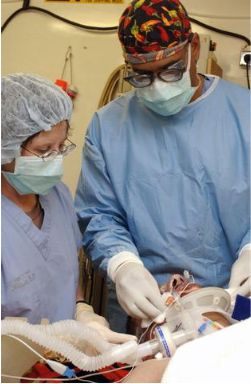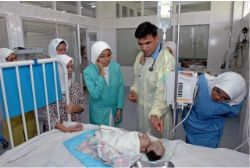|
SECTION IV. TRANSCULTURAL FACTORS INFLUENCING
NURSING CARE
1-27. INTRODUCTION
Transcultural nursing refers to the nursing
care of all patients, taking into consideration their religious and
sociocultural backgrounds. There are many variables to consider in giving nursing care to a
person of a race, religion, or culture different from your own. Respect for the patient, however,
is something all aspects of transcultural nursing have in common.
1-28. MAJOR FACTORS IN TRANSCULTURAL NURSING
-
Nutrition and dietary practices.
-
Beliefs about illness, its causes and
cures.
-
Disorders specific to a particular group,
such as the high incidence of sickle cell anemia among the Blacks.
-
Specific anatomical characteristics (e.g,
stature, skin tone, hair texture).
-
Religious beliefs about illness and death.
1-29.
VARIABLES RELATING TO THE TRANSCULTURAL ASPECTS OF
NURSING
Some of the factors are:
-
Cultural background of the nurse;
differences and similarities between the patient and the nurse.
-
Definition of health and illness accepted
by a specific culture; concepts relating to the causes of illness and injury.
-
Folk medicine practices.
-
Attitudes toward health care,
relationships, and interactions (e.g., personal space, eye contact).
-
Economic level of the patient and family
(socioeconomic status).
-
Environmental factors and related
disorders (e.g., ghetto living, lead poisoning).
-
Specific names and terms related to the
illness or disorder (e.g.,"bad blood," "mal ojo"); use of slang.
-
Language differences between the health
care staff and the patient and family.
-
Modesty and concept of the human body.
-
Reactions to pain, aging, and death.
-
Attitudes about childbirth, abortion,
sexual expression, children born to unmarried parents, and homosexuality.
-
Attitudes about mental illness and
retardation.
-
Diets in relation to religious and
cultural practices; dietary taboos.
-
Attitudes about physical appearance and
obesity; adaptation to special therapeutic diets.
-
Importance of religion and religious
practices.
-
Religious practices in illness and death;
specific prohibitions.
-
Group identity; importance and type of
family structure; cohesiveness within the group; traditional roles of men and
women.
|

Blacks and Raza/Latino cultures have long
used roots, potions, and herbs for treating illnesses. |
|
|
-
"Visibility" of ethnic background (that
is, Black, Oriental).
-
Disorders specific to a cultural group
(that is, Tay-Sachs, sickle cell anemia).
-
Attitudes about school; educational level
and aspirations of most members of the group.
-
Predominant occupations within the group;
role models.
-
"Americanization" of younger members.
-
Numbers of people belonging to that group
in the same geographic area as the health care facility.
-
Prejudices within a cultural group
relating to other members of the same group.
-
Stereotypes about other cultural/ethnic
groups.
-
Mixed families (mixed races, religions, or
cultural backgrounds).
1-30.
SOCIOCULTURAL BELIEFS ABOUT ILLNESS, ITS CAUSES, AND
CURES
Examples of Differences in Beliefs About
the Causes of Illness.
Japanese Shintoist.
Native Americans. Native Americans follow these three
concepts:
-
Prevention.
-
Treatment.
-
Health maintenance.
The person's health is defined in terms
of the person's relationship with nature and the universe.
Examples of Differences in Treatment of
Disorders.
Blacks and Raza/Latino cultures have long
used roots, potions, and herbs for treating illnesses.
Filipinos and Raza/Latino groups believe
that:
-
Hotness and coldness, wetness and
dryness, must be balanced to be healthy.
-
Certain illnesses are hot or cold, wet or
dry.
-
Certain foods and medications, classified
as hot or cold, are added or subtracted to bring about a balance of
humors or to fight off "hot" or "cold" illnesses.
Copper bracelets are worn by some groups
as a preventive or cure for arthritis.
|

There are many variables to
consider in giving nursing care to a person of a race, religion, or
culture different from your own.
|
|
|
Other Cultural Influences to Consider
When Planning Nursing Care.
-
The nurse should take into consideration
the needs of people who practice folk healing. The folk healer (curandero
in Spanish) should be allowed to see the patient.
-
South Americans often wear chains to
drive away evil spirits. The nurse should not remove these unless it is
absolutely necessary.
-
Native American women are not likely to
seek early prenatal care. They believe that pregnancy is a natural, normal
process; a clinic or a hospital is associated with illness.
-
Many Latino patients believe that it is
dangerous to bathe immediately after delivery. The nurse must remember this
during postpartum care.
-
Many cultural groups, such as Native
Americans and Southeast Asians, believe that it is improper or impolite to
look someone in the eye when speaking to him/her.
The Brookside
Associates Medical Education Division is dedicated to the development and
dissemination of medical information that may be useful to medical professionals
and those in training to become medical professionals. This website is
privately-held and not connected to any governmental agency. The views expressed
here are those of the authors, and unless otherwise noted, do not necessarily
reflect the views of the Brookside Associates, Ltd., any governmental or private
organizations. All writings, discussions, and publications on this website are
unclassified.
© 2007 Medical Education
Division, Brookside Associates, Ltd. All rights reserved
Other
Brookside Products
Contact Us

Advertise on this Site
|
|


